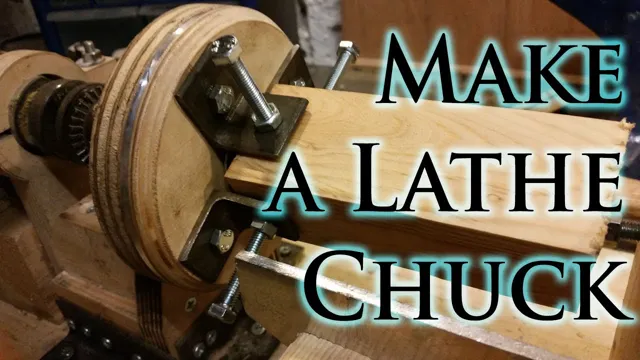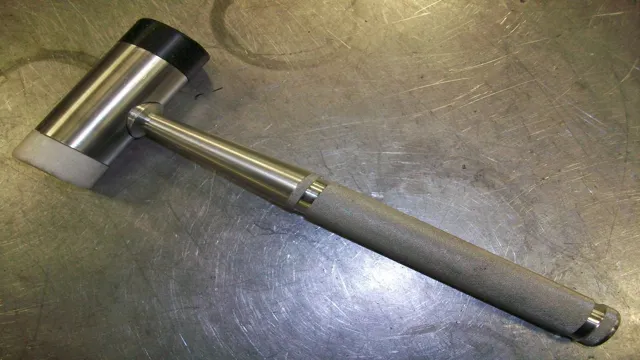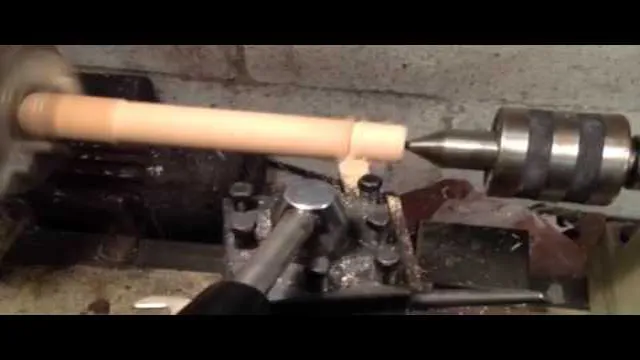
Do you have a metal lathe and missing a good chuck to hold your workpiece steady? Did you know that you can make your own metal lathe chuck right at home? It’s a simple yet rewarding project that will not only save you some money but will also allow you to expand your metalworking capabilities. A metal lathe chuck is an essential tool for any metalworker as it holds the workpiece in place and allows for precise cuts and machining. While you can purchase a chuck from a store, making one yourself gives you the freedom to customize the chuck to your needs and the satisfaction of creating something with your own two hands.
In this blog, we will guide you through the process of making your own metal lathe chuck step-by-step, from designing to finishing. We will cover every aspect of the project, including the materials needed, the tools required, and the techniques involved. You don’t have to be an expert in metalworking to complete this project – we will explain everything in detail and provide ample visual aids to make sure that you’re able to follow along with ease.
By the end of this blog, you’ll not only have a functional, custom-made chuck but also the knowledge and skills to tackle more complex metalworking projects. So, roll up your sleeves, grab your tools, and let’s get to work on creating a metal lathe chuck that will make all your metalworking endeavors more precise and satisfying.
Understanding Metal Lathe Chucks
Making a metal lathe chuck may seem like a daunting task, but with some proper understanding of the different components and how they work together, it can become a manageable project. The chuck is an essential part of a lathe, responsible for holding the workpiece in place while it undergoes machining operations. There are a few different types of chucks, including scroll chucks, independent jaw chucks, and collet chucks.
One way to make a lathe chuck is by utilizing a machining center, lathe, and a variety of other tools to craft the necessary components. These may include the jaws, screws, thrust bearings, and other components that make up the chuck. By carefully designing and constructing each piece, a metal lathe chuck can be fabricated to the necessary specifications and provide reliable performance for years to come.
Types of Metal Lathe Chucks
Metal lathe chucks are an essential component of any lathe machine. These chucks are used for holding and rotating the workpiece. There are different types of metal lathe chucks available in the market, and as a metalworker, it’s important to choose the right type for the job.
The most common types of metal lathe chucks are three-jaw chuck, four-jaw chuck, and collet chuck. The three-jaw chuck is the simplest and most versatile type of lathe chuck. It’s commonly used for round workpieces and has three jaws that self-center the workpiece.
The four-jaw chuck, on the other hand, is more complicated and is used for irregularly-shaped workpieces. It has four independently adjustable jaws that can be used to hold the workpiece in place firmly. Lastly, the collet chuck is a specialized type of chuck that’s commonly used for small cylindrical workpieces.
It’s a precision chuck that provides excellent grip and accuracy while holding the workpiece. When choosing a metal lathe chuck, it’s important to consider the size, type, and material of the workpiece to be held. Matching the right chuck with the right job will ensure the best results and improve your overall efficiency.

Choosing a Material for Your Chuck
Metal lathe chucks are a crucial component of a lathe machine and deciding on the material of the chuck is essential. There are three main materials to choose from: steel, aluminum, and iron. Steel is the most popular choice due to its durability and resistance to wear and tear.
It can withstand heavy loads and high-speed operations. Aluminum chucks are lighter in weight, making them ideal for smaller and lighter workpieces. They are less durable than steel and can deform easily under a heavy load.
Iron chucks are more robust than aluminum, but not as durable as steel. However, they are more affordable and are suitable for less demanding operations. It’s essential to choose the appropriate chuck material for your workpiece to achieve precise and accurate results.
Taking into consideration the workpiece’s size, weight, and nature of operation is crucial in determining the right metal lathe chuck material to use.
Steps for Making a Metal Lathe Chuck
If you’re looking to create your own metal lathe chuck, there are a few important steps to follow. First, gather all the necessary materials, including a solid metal bar, a drill press, a lathe chuck key, and a lathe. Then, create a rough design or sketch of your desired chuck shape and measurements before carefully marking and drilling holes in the metal bar.
Once holes have been drilled and tapped, mount the chuck onto the lathe and adjust to the desired level of precision using the key. With patience and attention to detail, anyone can create a high-quality metal lathe chuck for their machining needs. Just remember to take the time to plan ahead, have the right tools and materials on hand, and proceed with care and precision to ensure the best possible results.
So, why not give it a try and see how you can elevate your machining game with a custom-made metal lathe chuck?
Step 1: Acquire the Necessary Tools and Materials
If you’re looking to make your own metal lathe chuck, the first step is to acquire the necessary tools and materials. You’ll need a lathe, drill, taps, calipers, and a chuck blank, which you should be able to find at a local metalworking supply store. You’ll also need some cutting oil and a center drill bit to help you get started.
Once you have all of your tools and materials, it’s time to get started on the actual process of making your chuck. It’s important to take your time and be careful, as working with metal can be dangerous and you want to make sure that you end up with a high-quality product. With the right tools and some patience, however, you’ll be able to make a functional and reliable metal lathe chuck that you can use for years to come.
Step 2: Choose Your Chuck Design
When it comes to making a metal lathe chuck, choosing the right design is crucial. The chuck is the part of the lathe that holds the workpiece securely in place while it is being machined or turned, so it needs to be robust and reliable. There are various chuck designs to choose from, including three-jaw, four-jaw, and six-jaw chucks, each with its own advantages and disadvantages.
Three-jaw chucks are the most common and easiest to use, providing fast and accurate centering. Four-jaw chucks offer greater flexibility and the ability to hold irregularly shaped workpieces. Six-jaw chucks provide the most gripping power and are ideal for heavier workpieces.
Ultimately, the choice of chuck design will depend on the specific requirements of your project and the type of workpiece you are machining. By selecting the right design, you can ensure that your metal lathe chuck performs to the highest standards, delivering precise, accurate results every time.
Step 3: Machine the Chuck Body
In order to complete the production of a metal lathe chuck, the next step is to machine the chuck body. This involves shaping and smoothing the raw material, such as steel or iron, into the desired shape for the chuck. The process may vary depending on the type of chuck being produced, but generally involves turning the chuck on a lathe and using cutting tools to remove excess material.
A skilled machinist will carefully control the speed and pressure of the cutting tools to achieve precision and accuracy in the final product. This step is crucial to ensure that the chuck body is the correct size and shape to securely hold the workpiece during lathe operations. Overall, machining the chuck body requires a high level of skill and attention to detail to produce a functional and durable metal lathe chuck.
Step 4: Drill and Tap the Chuck Body
Now that you have drilled a center hole and counterbore, it is time to take the next step in making a metal lathe chuck by drilling and tapping the chuck body. This process allows you to attach the chuck jaws to the body of the chuck. First, you need to determine the correct size of the hole for your chuck jaws and choose a drill bit accordingly.
Typically, a drill press is used for this task to ensure accuracy and precision. Once the hole is drilled, it is time to tap the hole using the correct size of tap. The tap helps to create threads in the hole so that you can screw the jaws into place.
This step requires finesse and patience because it is essential to ensure that the hole is tapped at a perfect right angle to the chuck body surface. The right tool and a steady hand can make all the difference. Once the tap has created the threads, the chuck is almost ready for use.
Now, all that remains is to screw in the jaws and tighten everything up with a wrench. You are now ready to use your homemade metal lathe chuck to take on any project that comes your way.
Step 5: Create the Chuck Jaws
One of the essential steps in making a metal lathe chuck is creating the chuck jaws. These jaws are the primary gripping mechanism of a lathe, and they must be precise and reliable. The first step in creating the chuck jaws is to select the appropriate material, such as steel, aluminum, or brass.
The next step is to determine the dimensions of the jaws based on the desired lathe size. Once the dimensions are known, the steel blanks can be cut and machined to create the jaws. The final step is to harden and temper the jaws to ensure they can withstand the rigors of machining.
Careful attention must be paid to each step to ensure that the final product is of high quality and meets all necessary specifications. Creating the chuck jaws is a critical step in making a metal lathe chuck, and it is essential to take care in each step to ensure the final product is reliable and accurate.
Step 6: Assemble the Chuck
When it comes to making a metal lathe chuck, assembling the chuck is a crucial step that requires utmost care and attention to detail. Start by cleaning the spindle threads and inserting the chuck. Tighten the chuck using a torque wrench, making sure the jaws are adjusted to the correct position.
It is important to verify that the jaws are gripping the chuck key squarely before opening or closing the chuck. Once that is done, insert your workpiece and center it using a tailstock. Assemble the chuck key and tighten the jaws securely.
By following these steps and paying attention to every detail, you can ensure a precise and accurate result when using your metal lathe chuck. So, if you want to get the best out of your metal lathe, don’t overlook the importance of assembling the chuck properly.
Tips for Successful Chuck Making
If you’re interested in making your own metal lathe chuck, there are a few things you should keep in mind to ensure a successful outcome. First and foremost, make sure you have all the necessary tools and materials on hand before getting started, including a lathe, chuck jaws, and a chuck key. It’s also important to pay close attention to the specifications of the chuck, including its size and threading, to ensure a proper fit with your lathe.
Take the time to carefully measure and mark your material before starting to cut or drill, as precision is key to creating a functional and durable chuck. And don’t forget to double-check your work as you go, making any necessary adjustments or corrections before moving on to the next step. With a little patience and attention to detail, you can create a high-quality metal lathe chuck that will serve you well for years to come.
Safety Considerations
When it comes to making chucks for your woodworking projects, it’s important to keep safety in mind. One of the most important tips for successful chuck making is to always wear appropriate personal protective equipment, such as safety glasses and gloves. It’s also important to make sure your tools are in good working order before beginning, and to use them correctly and with care.
The chuck should be securely attached to the lathe and the workpiece should be properly secured before starting your project. Additionally, it’s important to use the correct size and type of chuck for your project to avoid any accidents or damage. By following these tips and prioritizing safety, you can create beautiful, high-quality projects with your chucks without putting yourself or others at risk.
Proper Tool Usage and Maintenance
Proper Tool Usage and Maintenance One of the most crucial aspects of successful chuck making is understanding how to use your tools properly and maintain them effectively. First and foremost, always read the manufacturer’s instructions to ensure you’re using the chuck in the intended manner. Additionally, make sure you’re using the appropriate tool size for your project, as using a larger or smaller tool than necessary can damage the chuck or compromise your results.
In terms of maintenance, regularly clean and lubricate your chuck to prevent rust buildup and ensure smooth operation. After each use, remove any debris, dust or shavings and wipe down the chuck with a clean cloth. Consider using a dedicated cleaning solution to remove any stubborn residue or buildup.
Another essential aspect to keep in mind is never overriding the chuck’s capacity or tightening the jaws too much. This can cause damage to the chuck, as well as put yourself and anyone nearby at risk of injury. When in doubt, refer to your manufacturer’s guidelines for safe and proper usage.
By following these tips, you can ensure that your chuck remains in top condition and provides consistent, accurate results for your woodworking projects. Proper tool usage and maintenance not only prolongs the life of your tools but also enhances the quality of your work.
Precision and Accuracy
When it comes to creating a successful chuck, precision and accuracy are key. It’s important to take the time to measure and double-check all the dimensions to ensure that the chuck will fit perfectly and perform as intended. One tip for successful chuck making is to use high-quality materials that are durable and long-lasting.
Additionally, be sure to use the right tools and techniques to ensure that the chuck is manufactured to the highest standards. By taking the time to carefully plan and execute each step of the process, you can create a high-quality chuck that will provide reliable performance for years to come. Overall, precision and accuracy are the keys to successful chuck making, and by following these tips, you can create a product that is both reliable and efficient.
Final Thoughts and Additional Resources
In conclusion, making a metal lathe chuck is a complex process that requires knowledge of metalworking techniques and tools. However, with the right materials and guidance, it is possible to create a customized chuck that meets your specific needs. Whether you choose to make a three-jaw or four-jaw chuck, it is important to follow safety precautions and take your time to ensure an accurate and functional outcome.
If you are interested in learning more about metalworking projects and techniques, there are many online resources available, including instructional videos, forums, and blogs. By incorporating these additional resources into your learning process, you can hone your skills and build upon your knowledge to create even more complex and intricate metalworking projects in the future. So, why not give it a try and see what you can create with your newfound metalworking skills?
Conclusion
And there you have it! With a little bit of patience, skill, and a whole lot of metalworking know-how, you too can create your very own metal lathe chuck. It’s the perfect project for those who love to tinker, appreciate precision engineering, and enjoy the satisfying hum of a lathe in action. So go on, give it a try – who knows, you might just create the next indispensable tool for the metalworking world!”
FAQs
1. What materials are needed to make a metal lathe chuck? A: To make a metal lathe chuck, you will need steel rods, a lathe, a drill press, a tap and die set, and scrap metal. 2. Is it difficult to make a metal lathe chuck? A: Making a metal lathe chuck requires some basic metalworking skills and knowledge of how to operate a lathe and other metalworking tools. With some practice and patience, it can be a rewarding project. 3. What are the benefits of making your own metal lathe chuck? A: Making your own metal lathe chuck allows you to customize it to your specific needs and requirements. It can also save you money compared to buying a pre-made chuck. 4. Can a beginner make a metal lathe chuck? A: While making a metal lathe chuck may be challenging for a beginner, it is not impossible. It is important to start with simple projects and work your way up to more complex ones. 5. What are some tips for making a metal lathe chuck? A: Some tips for making a metal lathe chuck include using high-quality materials, double-checking all measurements, and taking your time to ensure accuracy and precision. 6. How long does it take to make a metal lathe chuck? A: The time it takes to make a metal lathe chuck will depend on your skill level and the complexity of the project. It can take anywhere from a few hours to several days or weeks. 7. Are there any safety precautions to take when making a metal lathe chuck? A: Yes, it is important to wear appropriate safety gear such as goggles, gloves, and ear protection when operating metalworking tools. It is also important to be aware of potential hazards such as sharp objects and flying debris.








